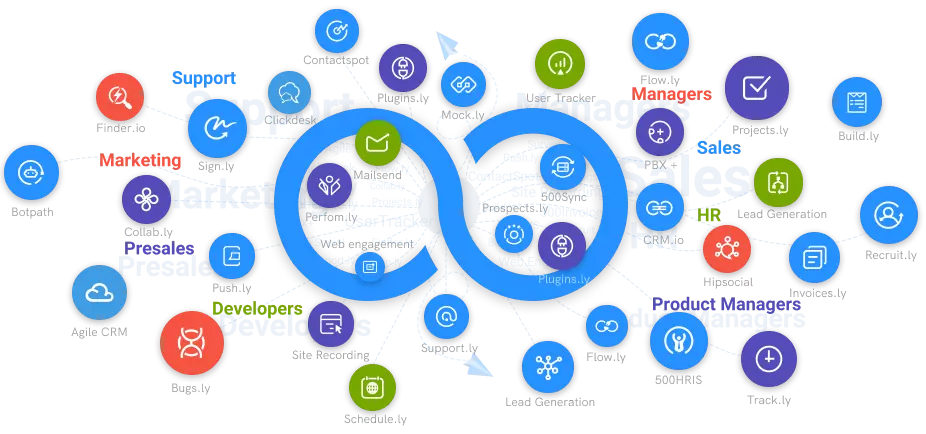What Are the Benefits of Rpa Software for Businesses?
Robotic Process Automation (RPA) is a technology that enables organizations to automate procedures and operations that would otherwise be performed by people. This solution is adaptable to many applications, platforms, and departments.
#1
Automated Repetitive Tasks
#2
End-to-End Bot Development
#3
Customized Bot Builder
#4
Unlimited Automated Workflows Management
#5
Automated Data Extraction
#6
Workflows Recording Management
#7
Rule-based Process Automation
#8
Seamless Data Management
#9
Unbelievable pricing - the lowest you will ever find
#10
Everything your business needs - 50 apps, 24/5 support and 99.95% uptime
There are numerous successful ways to apply RPA, some of which are listed below:
1. Customer Support
Customers in the modern day are accustomed to rapid replies and effective solutions. With the aid of automation, it is feasible to offer the outcomes that clients desire. Automated customer service systems can filter inquiries and provide preliminary replies to consumers. The automatic system can categorize inquiries, such as the tech department, service department, and others. Sorting ensures that inquiries are sent to the appropriate customer service employee for a timely reply. There is no need to switch the customer's call from one executive to another. Several rule-based procedures in customer service may be automated and simplified. According to studies, around 70% to 80% of rule-based procedures may be automated, and an excellent place to start is with customer support.
2. Processing of Invoices
The high volume of invoice processing necessitates repetitive manual activities, which might lead to late and erroneous payments. Vendors may supply excellent goods/services if payments are made on time. Many problems exist in invoice processing, such as invoices with formats, the need to merge data from multiple sources into a unified financial database system, and so on. When invoices are received, RPA automatically processes them. OCR may be used to automate the paper-based invoice format. RPA may automate data entry, reconciliation errors, and even some decision-making necessary for invoice processing, reducing the need for human interaction. RPA has the ability to automate the whole process, from reception to payment.
3. Orders for Sales
Data consistency across business systems is a time-consuming process. Sales representatives must devote crucial time to entering data into the CRM and ERP systems. Finance analysts must duplicate the data and enter it into a different system or module. This may result in duplication, mistakes, and a decrease in production. RPA can handle sales operations from start to finish by automating duties like sales order input, invoicing, and so on. It will assist to manage a database by deleting duplicate data, enhance customer experience, and boost the happiness of your sales personnel by removing all time-consuming activities such as data entry so that they can focus on their core task- prospecting and creating more revenue.
4. Payroll
Payroll processing is a time-consuming, repetitive activity for any organization's HR personnel, and it also necessitates a huge volume of data input efforts. This might lead to data inaccuracies, which can lead to payment delays and employee discontent. RPA can check timesheets, load earnings, and deductions, as well as verify employee data integrity across different systems. It may also automate the generation of paychecks, as well as the administration of benefits and reimbursements. To minimize errors and delays, RPA may automate payroll-related activities from start to finish.
5. Comparison of Prices
Businesses frequently need to make bulk purchases in order to create products or offer services. The cost of these goods might have an influence on the company's income or profits; firms always conduct research online before making a choice. The research process may be time-consuming and complex, which is why many businesses have begun to use RPA. The system compares not just costs from multiple suppliers, but also product characteristics and quality. Businesses may obtain the greatest resources at the most competitive costs.
6. Data Storage for Customers
RPA can assist you in storing, sorting, and organizing all types of client information to guarantee that everything is conveniently accessible. The system will automatically classify data such as contact information, purchasing history, preferences, and personal information such as birthdays and anniversaries. The system may show all of the information to customer service representatives, salespeople, and other personnel. There's no need to enter this information manually or worry about its correctness. RPA is more accurate and has a narrower margin of error than humans. Storing information is one of the most time-consuming and stressful occupations. RPA use may minimize repetitive activities by approximately 80%.
7. Processing Human Resources Data
It is a difficult effort to store and process HR information. It takes a long time and can be a difficult procedure. A successful firm creates massive volumes of personnel data, which may be challenging to filter and manage. The RPA system can gather and arrange all of the information required by your HR department. RPA can filter and store information such as personnel history, payroll, reimbursements, and degree of training. It can handle all of your day-to-day responsibilities, freeing up your HR staff to focus on the human side of things. They can focus on enhancing staff productivity and work culture, something robots cannot manage.
8. Refunds & Processed Quickly
The speed with which a firm can process refunds determines its reputation. Customers want this process to be as quick and painless as possible, but that is easier said than done. Complaints and return requests create a large amount of data that might be time-consuming to go through. The RPA system handles the situation efficiently and quickly executes the refund. This enhances the entire consumer experience and boosts your reputation.
9. Recruitment
Robotic Process Automation may also aid in recruitment, greatly streamlining the process. The system may gather resumes from many platforms, access value, filter out spam or unwanted applications, and other criteria. This can significantly speed up the recruitment process. It can alleviate recruiters' stress and allow them to properly assess each application. RPA can manage 90 percent to 95 percent of critical recruiting activities such as screening, assessing, measuring, onboarding, and administration.
10. Data Extraction from Various Formats
Data may be presented in a variety of ways, ranging from editable text to handwritten notes. Data entry specialists have a difficult time reading information and entering it into the system. Optical character recognition technology can quickly read information from various formats and enter it into the system.
As you can see, RPA may be used in a variety of fascinating ways. It takes some experience, but your staff will quickly adjust to the changes and continue to work successfully. We urge organizations to experiment with AutomationEdge RPA. You do not have to deploy system-wide automation from the start. Begin small and automate one operation at a time to determine if it is the best option for your organization.





